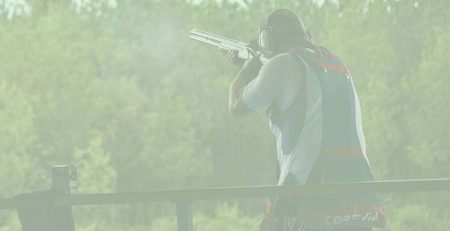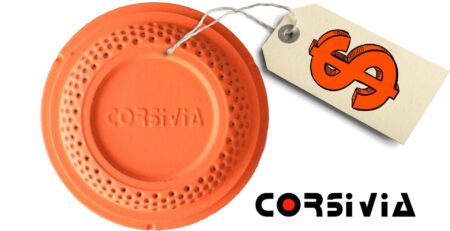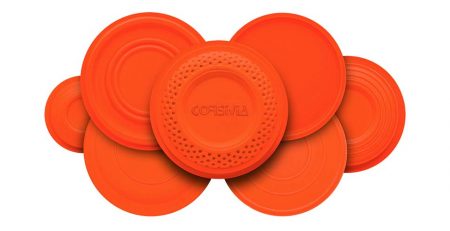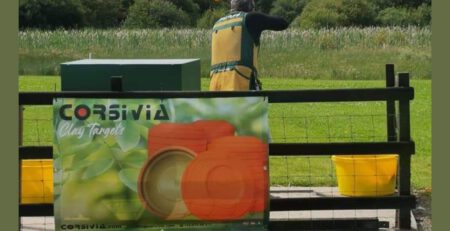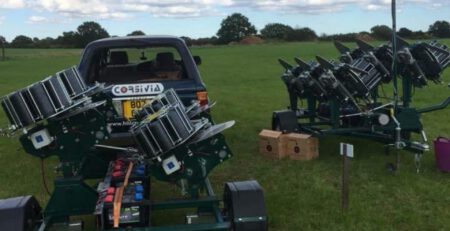TRAP: WHAT IT IS AND HOW TO BUILD A TRAP SHOOTING RANGE
As you already know, Trap is both an Olympic and a Sporting discipline. Each of them has its own rules, both for the practice of our beloved sport, as for the specifications that must meet in a shooting range of this modality.
Today we are going to talk about the keys you need to know to build an Olympic Trap shooting range, but first we are going to review these two modalities.
Here we go!
UNIVERSAL TRENCH: THE MODALITY FOR THE MORE DARING
The Universal Trench is considered one of the disciplines in which the shooter must always be alert to be able to act quickly, because the targets are launched randomly from the 5 trap machines.
It is a modality in which it is necessary for the shooter to have a very good composure and technique, which makes it one of the favourites of the most experienced shooters.
In the pit, installed in front of the shooting stations, there are 5 machines, each of which bases the launching of the targets, controlled by a distributor, on one of the 10 official schemes established by the FITASC.
Although the trajectories of the targets vary from shooter to shooter, all shooters fire the same number of targets at the end of each round.
The targets used in this modality are 11 centimetres in diameter. Shotguns must be of 12 gauge and cartridges of up to 28 grams of lead.
In a Universal Trench championship, 8 heats are shot with a total of 200 targets, that is, 25 targets for each heat.
OLYMPIC TRAP
In this modality, regulated by the ISSF, and considered as the most representative Olympic discipline, a total of 15 trap machines are used, 3 for each of the 5 shooting positions.
From each position, 5 trajectories are shot in each of the 5 rounds, with a total of 125 targets for the men’s category, while in the women’s category a total of 75 targets are shot in 3 series of 25 each.
For this discipline, 11-cm clay targets are also used. Their output speed is around 120 km/hour, and they are configured to travel up to 80 meters at different heights.
The shooter is aware of the point of origin of the target, but does not know the angle of exit. Therefore, the shooter’s reflexes, concentration and shooting speed will be decisive to achieve the best results.
A 12 gauge shotgun and cartridges of 24 grams of lead are used for the practice of the Olympic Trap.
CHARACTERISTICS AND SAFETY MEASURES AT SHOOTING RANGES
We already told you about it in our article “Steps and regulations to follow to build a shooting range“.
But it is not out of place to make a small reminder of some of them, which, In Spain, you will find in the annex of the Weapons Regulation in its article 150.
These measures focus on four essential points to be taken into account:
- Safety zone: comprised within a circular sector of 45 degrees on both sides of the shooter and 200 meters radius.
- Protection of the trap machines, which must be protected inside a subway construction with a concrete roof.
- Spectator protection: The area provided for this purpose must be located behind the shooters’ backs, and access to the shooting range must be from the rear or perpendicular to the firing line.
- Enclosure and signage: Ideally, the field should be fenced around its entire perimeter.
Please, refer to the annex mentioned above for more information.
SPECIFICATIONS FOR BUILDING A TRAP SHOOTING RANGE
In this type of field (discipline of which we have already talked about in this article of our blog), a shooting line will be placed with a determined unit of posts, parallel to a pit, placed at a distance, according to regulations, where the trap machines will be located.

The housing of trap machines should be constructed so that the highest surface of the roof is at the same level as the surface of the firing positions. The interior dimensions of the pit should be approximately 20 m from end to end; 2 m from the front to the rear and 2 to 2.10 m from the floor to the underside of the roof. These dimensions should allow freedom of movement for the work of the personnel and sufficient space to store the plates.

The trap machines, as well as the operators, must be protected inside a subway construction with a concrete roof, since they will always be within the line of fire.
HOW TO ARRANGE THE TRAP MACHINES IN THE PIT
Each pit must have 15 machines fixed to the floor or the front wall of the pit and must be divided into 5 groups of three. The centre of each group must be indicated only by a mark painted on the top of the roof, which must be positioned to indicate the point on the central machine of each group from which the plate will come out when the zero degree throw is selected.
The distance between machines, within each group, must be equal and from 1.00 m to 1.10 m. The distance between the central machines of the groups should be from 3 m to 3.30 m. For existing courts, it can be from 3.00 to 6.00 m.
In case machines are used where the shuttle rotates clockwise, the distance between the machine on the left (as seen from behind) and the one in the centre of each group can be reduced to less than 1.00 m to 1.10 m.
Machines should be installed in the pit so that the stud on which the launcher rotates is 0.50 m (+ 0.10 m) below the top of the pit roof and 0.50 m back (+ 0.10 m) from the front edge of the roof, when the machine is set at 2 m. height.
HOW THE FIVE FIRING POSITIONS SHOULD BE ARRANGED

The five shooting stands must be arranged in a straight line, at a distance of 15 m backwards from the front edge of the pit. Each shooting stand must be indicated by a square, 1 m by 1 m, clearly delimited, and must be centred on a line perpendicular to the shooting stand line, which must extend towards the painted mark indicating the zero degree launch point on the central machine of each group of three.
A sixth position should be marked, about two meters back and slightly to the left of position 1, where athlete number 6 should be placed.
All six stands must be provided with a table or bench where athletes can place their surplus cartridges and other accessories. The stands should be firm and level in all directions. Each stand should have a piece of wood or piece of carpet or rubber about six inches square or round, on which the sportsman can rest his gun.
WHAT ARE THE BEST CLAY TARGETS FOR TRAP PRACTICE?
Without a doubt, we cannot recommend any other clay targets than our beloved Olympic and Green Dream.
For the practice of Universal Trench, nothing better than our Olympic clay target. A target widely used for this discipline in France and that offers multiple advantages:
- It is manufactured with sufficient consistency to withstand the output of the shot-blasting machine and break with the minimum impact of the pellets.
- It offers a consistent and stable flight path.
- It offers less than 1% of null birds.
- And it features high visibility.
For Olympic Trap practice, the Green Dream is the best clay target for reasons such as these:
- Manufactured with natural resins. PAH = 0.
- Same advantages as our traditional clay target.
- Superior visibility.
- Excellent breakage, causing huge smoke clouds.
- Certified by Bureau Veritas ISO 14021.
Both with permanent stock in our facilities and immediate delivery to any country in the world.
Now you have all the information you need to build your own Trap shooting range or to check that everything is correct in your working shooting range.
Anyway, if you need us to give you a hand, remember that we put at your disposal our Coworking Service for anything you may need.


